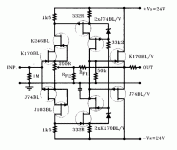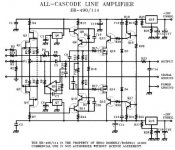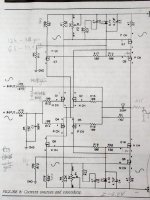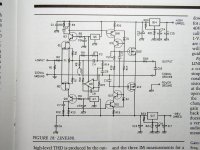The Son of Dork (SOD) project is the result of the diyAudio.com multi-channel preamp initiative (http://www.diyaudio.com/forums/showthread.php?threadid=3517). The project has been split into threads dedicated to discussion of the preamp's different functional units:
- General Discussion (project status, functional requirements)
- Active Circuitry
- Attenuator
- Power Supply
- Connections and Layout (including input switching)
- Chassis and Construction
- Hardware Logic, Controls, Display
- Microprocessor (programming, implementation)
I will be managing the project as a whole, as well as initially overseeing individual threads. For a background on the project, please see the original thread referenced above. A website dedicated to the project will be located at http://dorkus.org/diy/sod.
Let the fun begin!
- General Discussion (project status, functional requirements)
- Active Circuitry
- Attenuator
- Power Supply
- Connections and Layout (including input switching)
- Chassis and Construction
- Hardware Logic, Controls, Display
- Microprocessor (programming, implementation)
I will be managing the project as a whole, as well as initially overseeing individual threads. For a background on the project, please see the original thread referenced above. A website dedicated to the project will be located at http://dorkus.org/diy/sod.
Let the fun begin!
Borbely superbuffer
Hello guys,
I am an absolute beginner in DIY audio, but since there's a lot about Borbely, what do you think of his superbuffer in
http://www.borbelyaudio.com/borb502.pdf[/URL]
Hello guys,
I am an absolute beginner in DIY audio, but since there's a lot about Borbely, what do you think of his superbuffer in
http://www.borbelyaudio.com/borb502.pdf[/URL]
Attachments
the borberly DC-coupled FET line amp we were talking about (the one the single-ended guys didn't like 😛) is actually a tweaked-out version of the super buffer. the line amp includes source followers for additional output drive capability, and a servo for better DC stability. i suspect it sounds pretty good but i've never tried it, i'm probably going to try the full line amp version. check out the article on the borberly site on the all-FET line amp, from the 5/02 issue of AudioXPress, it mentions the super buffer.
Borbely line stage
Isn't that the same 12 year old circuit that HPotter posted in the previous thread on this topic?
H.H.
Isn't that the same 12 year old circuit that HPotter posted in the previous thread on this topic?
H.H.
no
this is the all cascode, it has cascodes in the folower stage.
as for the older one posted on the other thread, i dont like the way borbely bias the front stage cascode. wath do you guys think about that?
regrads
rick
this is the all cascode, it has cascodes in the folower stage.
as for the older one posted on the other thread, i dont like the way borbely bias the front stage cascode. wath do you guys think about that?
regrads
rick
i dont like the way borbely bias the front stage cascode
Stranger..... we don't discuss cascodes in front of the children and women folks 'round here. You take that kinda talk elsewhere......
H.H.
Stranger..... we don't discuss cascodes in front of the children and women folks 'round here. You take that kinda talk elsewhere......
H.H.
original "super buffer" vs. EB-1198
you are right ren, the latest complementary FET design from borbely does not cascode the output stage, only the diff inputs and 2nd gain stage. the output are traditional source followers using MOSFETs.
i am starting to wonder if the "super buffer," from which the latest design is derived, is worth a try. borbely mentions that the latest one (the EB-1198, we should really refer to these by model # from now on to avoid confusion) was designed with even greater drive capability in mind - he wanted to be able to drive 100 ohm headphones in Class A w/low distortion. this sort of overkill is nice in a preamp but not necessary in most systems. the super buffer is a little simpler than the 1198 (one less active stage) and also does w/o the DC servo that people seem to have a strong distaste for. i wonder why the addition of the output stage necessitates a servo in the 1198, or is borberly just going for extreme DC stability there? in any case i think i may prototype the super buffer instead of the 1198, and compare that to the SE-FET design that the others favor. with very tight device matching, i think the performance could be quite good. thoughts?
oh, and speaking of the SE-FET design... does anyone have any concrete topology changes from the original design? if i can not get suggestions specific enough to be drawn out in a schematic, then i will just go with the original layout.
cheers,
marc
p.s. it seems to me that it is very dangerous to make broad generalizations about topics such as cascodes. analog design and analysis is so dynamic and complex that the effectiveness of a given technique can hardly be isolated, rather its role must be evaluated only in the context of the circuit's implementation and performance as a whole. if you want to talk about cascodes, you should really specify where and how it will be used or it is of little value to us. therefore, comments like "cascodes sound bad" will be summarily ignored from now on. 😀
you are right ren, the latest complementary FET design from borbely does not cascode the output stage, only the diff inputs and 2nd gain stage. the output are traditional source followers using MOSFETs.
i am starting to wonder if the "super buffer," from which the latest design is derived, is worth a try. borbely mentions that the latest one (the EB-1198, we should really refer to these by model # from now on to avoid confusion) was designed with even greater drive capability in mind - he wanted to be able to drive 100 ohm headphones in Class A w/low distortion. this sort of overkill is nice in a preamp but not necessary in most systems. the super buffer is a little simpler than the 1198 (one less active stage) and also does w/o the DC servo that people seem to have a strong distaste for. i wonder why the addition of the output stage necessitates a servo in the 1198, or is borberly just going for extreme DC stability there? in any case i think i may prototype the super buffer instead of the 1198, and compare that to the SE-FET design that the others favor. with very tight device matching, i think the performance could be quite good. thoughts?
oh, and speaking of the SE-FET design... does anyone have any concrete topology changes from the original design? if i can not get suggestions specific enough to be drawn out in a schematic, then i will just go with the original layout.
cheers,
marc
p.s. it seems to me that it is very dangerous to make broad generalizations about topics such as cascodes. analog design and analysis is so dynamic and complex that the effectiveness of a given technique can hardly be isolated, rather its role must be evaluated only in the context of the circuit's implementation and performance as a whole. if you want to talk about cascodes, you should really specify where and how it will be used or it is of little value to us. therefore, comments like "cascodes sound bad" will be summarily ignored from now on. 😀
Dorkus and a preamp.....
Hello folkus...
I've looked at the thread and, to me, the idea of a preamp has certain ah, attractions. I know I'm coming in late and I know that what follows may be interpreted as an attempt to take over the discussion. It's not.
I'd like to haul the discussion back a little if I can and look at a basic need (for me) at least. That is, the components must be readily available through dealers that are accessible at a reasonable price.
This would seem to me to indicate op amps as many of the bits and bobs that are used in such as Borbely preamps are not readily available at reasonable prices (here in New Zealand at least).
I'd also like to propose an order of discussion which, to me, seems logical.
1. The architecture (number of gain stages, the amount of gain, whether or not a headphone amplifier, tape buffers, position of volume/balance controls and so on.)
2. The structure of inputs and outputs, number of, switching methods (relays, solid state etc).
3. How volume/balance will be done, actively, passively and by wht chips/pots etc.
4. Gain stages and buffers, design etc.
5. Power supplies (series, shunt, etc)
6. Control circuitry and programming, what microprocessor and who does the programming... includes displays
7. PC boards and layouts
8. Case and so on.
I've been involved in a system like this and the project never got off the ground because of a lack of structure to the discussions. Even within such, a loty of fun can be had. What do you think, and let's have some fun!
kindest regards, Keith
Hello folkus...
I've looked at the thread and, to me, the idea of a preamp has certain ah, attractions. I know I'm coming in late and I know that what follows may be interpreted as an attempt to take over the discussion. It's not.
I'd like to haul the discussion back a little if I can and look at a basic need (for me) at least. That is, the components must be readily available through dealers that are accessible at a reasonable price.
This would seem to me to indicate op amps as many of the bits and bobs that are used in such as Borbely preamps are not readily available at reasonable prices (here in New Zealand at least).
I'd also like to propose an order of discussion which, to me, seems logical.
1. The architecture (number of gain stages, the amount of gain, whether or not a headphone amplifier, tape buffers, position of volume/balance controls and so on.)
2. The structure of inputs and outputs, number of, switching methods (relays, solid state etc).
3. How volume/balance will be done, actively, passively and by wht chips/pots etc.
4. Gain stages and buffers, design etc.
5. Power supplies (series, shunt, etc)
6. Control circuitry and programming, what microprocessor and who does the programming... includes displays
7. PC boards and layouts
8. Case and so on.
I've been involved in a system like this and the project never got off the ground because of a lack of structure to the discussions. Even within such, a loty of fun can be had. What do you think, and let's have some fun!
kindest regards, Keith
Keith,
Take time to read the first post of this thread, and the previous long thread on this topic, and most, if not all of your questions will be answered.
--
Brian
Take time to read the first post of this thread, and the previous long thread on this topic, and most, if not all of your questions will be answered.
--
Brian
by the way...
has anyone built ANY of these circuits we've talked about? i think someone, jam maybe, said they've tried most of them but does anyone still have a working version they've listened to extensively and can comment on? apart from the circuit theory i'd like to have some listening impressions.
also, has anyone tried building the forssell design:
http://www.forsselltech.com/JFET Opamp.PDF
yes it's an opamp but hey who knows maybe it sounds really good.
has anyone built ANY of these circuits we've talked about? i think someone, jam maybe, said they've tried most of them but does anyone still have a working version they've listened to extensively and can comment on? apart from the circuit theory i'd like to have some listening impressions.
also, has anyone tried building the forssell design:
http://www.forsselltech.com/JFET Opamp.PDF
yes it's an opamp but hey who knows maybe it sounds really good.
i'll be putting together a testbed in July and i'll do some listening tests on the various designs as have been suggested here and i'll try the various circuit variations such as SE with caps or SE with level-shift etc..........
july is so far away
i'll try to build a couple of them by mid-june... anyone know where i can get 2SJ74's? MCM has the 2SK170's but not the complementary J74's... man why doesn't toshiba make those awesome matched-pair single can JFETs anymore, bleh...
i'll try to build a couple of them by mid-june... anyone know where i can get 2SJ74's? MCM has the 2SK170's but not the complementary J74's... man why doesn't toshiba make those awesome matched-pair single can JFETs anymore, bleh...
Dorkus,
Yeah i know July is a long way away ... sorry about that but i dont get holidays till then 😀
Yeah i know July is a long way away ... sorry about that but i dont get holidays till then 😀
Tip Top Electronics
Has anyone tried
Tip Top Electronics
They seem to carry a lot of japanese semis - Toshiba, Hitachi, Sanken... for very low prices. Download
Semis Original Catalogue
I don't know what grades of semis they have. Just few are specified as GR or BL. 2SJ74 is not specified.
Has anyone tried
Tip Top Electronics
They seem to carry a lot of japanese semis - Toshiba, Hitachi, Sanken... for very low prices. Download
Semis Original Catalogue
I don't know what grades of semis they have. Just few are specified as GR or BL. 2SJ74 is not specified.
AC Coupling
i was just browsing through some old threads and came across an excellent post by AndreasJ on testing of different capacitor types. he was saying that polypropylene film types performed best, but even they had non-linearities at zero crossing. the best way to operate them is with DC bias, which correlates with listening observations people i know have made where all capacitors, regardless of type, seem to perform better with a stable DC bias.
maybe this is why AC coupling works so well in SE circuits - because the circuit by nature has a fixed DC offset, this in turn biases the cap, optimizing its performance to some degree. whereas if you stick a cap into a non-biased AC signal, you are more likely to get induced noise and distortion. that may be why i perceive even good film caps as colored, i am usually operating them around zero-crossing.
so in a SE circuit, i may be more amenable to capacitor coupling after all... just a thought.
you can see the original cap thread here:
http://www.diyaudio.com/forums/showthread.php?threadid=525
i was just browsing through some old threads and came across an excellent post by AndreasJ on testing of different capacitor types. he was saying that polypropylene film types performed best, but even they had non-linearities at zero crossing. the best way to operate them is with DC bias, which correlates with listening observations people i know have made where all capacitors, regardless of type, seem to perform better with a stable DC bias.
maybe this is why AC coupling works so well in SE circuits - because the circuit by nature has a fixed DC offset, this in turn biases the cap, optimizing its performance to some degree. whereas if you stick a cap into a non-biased AC signal, you are more likely to get induced noise and distortion. that may be why i perceive even good film caps as colored, i am usually operating them around zero-crossing.
so in a SE circuit, i may be more amenable to capacitor coupling after all... just a thought.
you can see the original cap thread here:
http://www.diyaudio.com/forums/showthread.php?threadid=525
- Status
- Not open for further replies.
- Home
- Amplifiers
- Solid State
- Son of Dork: Active Circuitry




